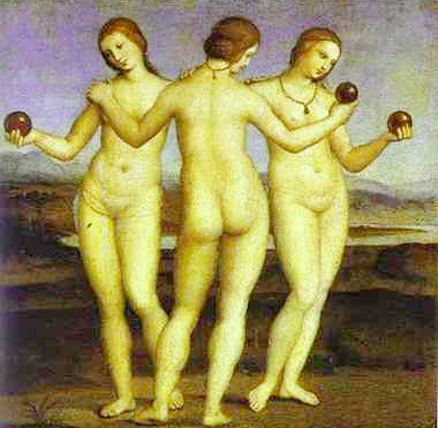The three charities (called in Latin, Graces) were ancient Greek divinities for beauty, grace and artistic inspiration. In their most archaic form, they represented the powers of vegetation. Usually they are described as three sisters called Euphrosyne, Thalia and Aglaea. Their father was Zeus and their mother was either Eurynome, or Hera. They are usually depicted as naked girls embracing at each other. They frequently accompany Apollo, Athena, Aphrodite, Eros and Dionysus.
Raffaello Santi, known as Raphael, or Raphael of Urbino, was born in Urbino on Good Friday 6 April 1483, the son of Magia di Battista di Nicola Ciarla and Giovanni Santi di Pietro. His father was a painter and poet at the court of Frederico da Montefeltre, one of the most famous princes and art patrons of Early Renaissance Italy. Raphael's father was not an outstanding painter, though he was a man of good sense. Raphael started helping out in Santi's studio at a very early age. It is believed that Raphael learned the fundamentals of art in his father's studio. But it is still unclear where Raphael received his training after this early period in his father's workshop, as Giovanni Santi died in 1494. According to his first biographer Vasari Raphael was apprenticed to Perugino, although there are no sources, which confirm that he worked with Perugino before 1500. All Raphael's surviving works from 1502 to 1504 show Perugino's influence, including the famous 'The Three Graces' painted between 1503 and 1504. The painting was widely reproduced and the three lovely sisters found their way into Master Giorgio's composition of maidens bathing in a pool on the previous plate.

'The Three Graces', by Raphael of Urbino, Italy, Oil on Canvas, 1503-1504 CE


